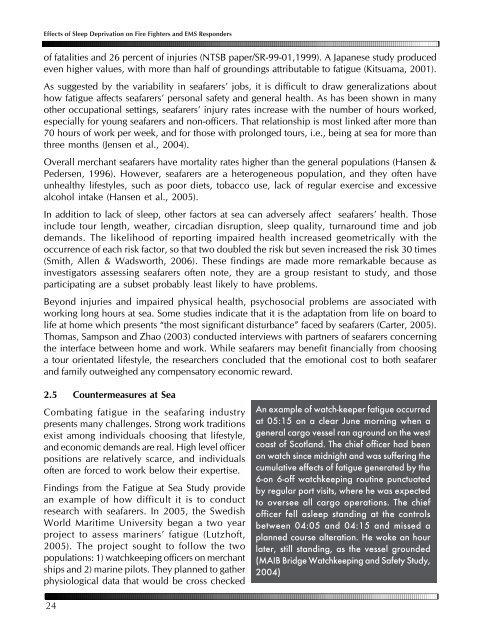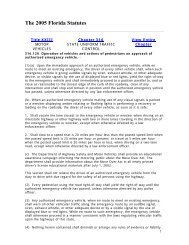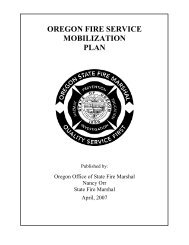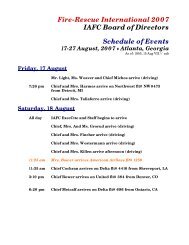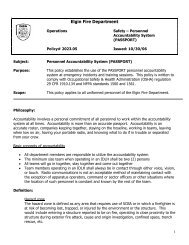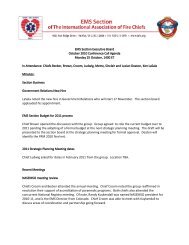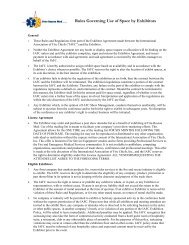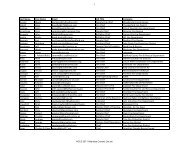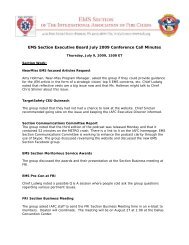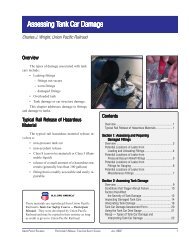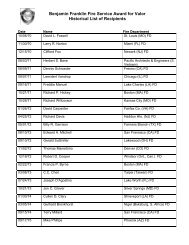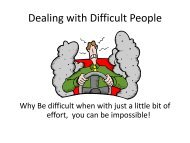Effects of Sleep Deprivation on Fire Fighters and EMS ... - NAEMT
Effects of Sleep Deprivation on Fire Fighters and EMS ... - NAEMT
Effects of Sleep Deprivation on Fire Fighters and EMS ... - NAEMT
You also want an ePaper? Increase the reach of your titles
YUMPU automatically turns print PDFs into web optimized ePapers that Google loves.
<str<strong>on</strong>g>Effects</str<strong>on</strong>g> <str<strong>on</strong>g>of</str<strong>on</strong>g> <str<strong>on</strong>g>Sleep</str<strong>on</strong>g> <str<strong>on</strong>g>Deprivati<strong>on</strong></str<strong>on</strong>g> <strong>on</strong> <strong>Fire</strong> <strong>Fighters</strong> <strong>and</strong> <strong>EMS</strong> Resp<strong>on</strong>ders<br />
<str<strong>on</strong>g>of</str<strong>on</strong>g> fatalities <strong>and</strong> 26 percent <str<strong>on</strong>g>of</str<strong>on</strong>g> injuries (NTSB paper/SR-99-01,1999). A Japanese study produced<br />
even higher values, with more than half <str<strong>on</strong>g>of</str<strong>on</strong>g> groundings attributable to fatigue (Kitsuama, 2001).<br />
As suggested by the variability in seafarers’ jobs, it is difficult to draw generalizati<strong>on</strong>s about<br />
how fatigue affects seafarers’ pers<strong>on</strong>al safety <strong>and</strong> general health. As has been shown in many<br />
other occupati<strong>on</strong>al settings, seafarers’ injury rates increase with the number <str<strong>on</strong>g>of</str<strong>on</strong>g> hours worked,<br />
especially for young seafarers <strong>and</strong> n<strong>on</strong>-<str<strong>on</strong>g>of</str<strong>on</strong>g>ficers. That relati<strong>on</strong>ship is most linked after more than<br />
70 hours <str<strong>on</strong>g>of</str<strong>on</strong>g> work per week, <strong>and</strong> for those with prol<strong>on</strong>ged tours, i.e., being at sea for more than<br />
three m<strong>on</strong>ths (Jensen et al., 2004).<br />
Overall merchant seafarers have mortality rates higher than the general populati<strong>on</strong>s (Hansen &<br />
Pedersen, 1996). However, seafarers are a heterogeneous populati<strong>on</strong>, <strong>and</strong> they <str<strong>on</strong>g>of</str<strong>on</strong>g>ten have<br />
unhealthy lifestyles, such as poor diets, tobacco use, lack <str<strong>on</strong>g>of</str<strong>on</strong>g> regular exercise <strong>and</strong> excessive<br />
alcohol intake (Hansen et al., 2005).<br />
In additi<strong>on</strong> to lack <str<strong>on</strong>g>of</str<strong>on</strong>g> sleep, other factors at sea can adversely affect seafarers’ health. Those<br />
include tour length, weather, circadian disrupti<strong>on</strong>, sleep quality, turnaround time <strong>and</strong> job<br />
dem<strong>and</strong>s. The likelihood <str<strong>on</strong>g>of</str<strong>on</strong>g> reporting impaired health increased geometrically with the<br />
occurrence <str<strong>on</strong>g>of</str<strong>on</strong>g> each risk factor, so that two doubled the risk but seven increased the risk 30 times<br />
(Smith, Allen & Wadsworth, 2006). These findings are made more remarkable because as<br />
investigators assessing seafarers <str<strong>on</strong>g>of</str<strong>on</strong>g>ten note, they are a group resistant to study, <strong>and</strong> those<br />
participating are a subset probably least likely to have problems.<br />
Bey<strong>on</strong>d injuries <strong>and</strong> impaired physical health, psychosocial problems are associated with<br />
working l<strong>on</strong>g hours at sea. Some studies indicate that it is the adaptati<strong>on</strong> from life <strong>on</strong> board to<br />
life at home which presents “the most significant disturbance” faced by seafarers (Carter, 2005).<br />
Thomas, Samps<strong>on</strong> <strong>and</strong> Zhao (2003) c<strong>on</strong>ducted interviews with partners <str<strong>on</strong>g>of</str<strong>on</strong>g> seafarers c<strong>on</strong>cerning<br />
the interface between home <strong>and</strong> work. While seafarers may benefit financially from choosing<br />
a tour orientated lifestyle, the researchers c<strong>on</strong>cluded that the emoti<strong>on</strong>al cost to both seafarer<br />
<strong>and</strong> family outweighed any compensatory ec<strong>on</strong>omic reward.<br />
2.5 Countermeasures at Sea<br />
Combating fatigue in the seafaring industry<br />
presents many challenges. Str<strong>on</strong>g work traditi<strong>on</strong>s<br />
exist am<strong>on</strong>g individuals choosing that lifestyle,<br />
<strong>and</strong> ec<strong>on</strong>omic dem<strong>and</strong>s are real. High level <str<strong>on</strong>g>of</str<strong>on</strong>g>ficer<br />
positi<strong>on</strong>s are relatively scarce, <strong>and</strong> individuals<br />
<str<strong>on</strong>g>of</str<strong>on</strong>g>ten are forced to work below their expertise.<br />
Findings from the Fatigue at Sea Study provide<br />
an example <str<strong>on</strong>g>of</str<strong>on</strong>g> how difficult it is to c<strong>on</strong>duct<br />
research with seafarers. In 2005, the Swedish<br />
World Maritime University began a two year<br />
project to assess mariners’ fatigue (Lutzh<str<strong>on</strong>g>of</str<strong>on</strong>g>t,<br />
2005). The project sought to follow the two<br />
populati<strong>on</strong>s: 1) watchkeeping <str<strong>on</strong>g>of</str<strong>on</strong>g>ficers <strong>on</strong> merchant<br />
ships <strong>and</strong> 2) marine pilots. They planned to gather<br />
physiological data that would be cross checked<br />
An example <str<strong>on</strong>g>of</str<strong>on</strong>g> watch-keeper fatigue occurred<br />
at 05:15 <strong>on</strong> a clear June morning when a<br />
general cargo vessel ran aground <strong>on</strong> the west<br />
coast <str<strong>on</strong>g>of</str<strong>on</strong>g> Scotl<strong>and</strong>. The chief <str<strong>on</strong>g>of</str<strong>on</strong>g>ficer had been<br />
<strong>on</strong> watch since midnight <strong>and</strong> was suffering the<br />
cumulative effects <str<strong>on</strong>g>of</str<strong>on</strong>g> fatigue generated by the<br />
6-<strong>on</strong> 6-<str<strong>on</strong>g>of</str<strong>on</strong>g>f watchkeeping routine punctuated<br />
by regular port visits, where he was expected<br />
to oversee all cargo operati<strong>on</strong>s. The chief<br />
<str<strong>on</strong>g>of</str<strong>on</strong>g>ficer fell asleep st<strong>and</strong>ing at the c<strong>on</strong>trols<br />
between 04:05 <strong>and</strong> 04:15 <strong>and</strong> missed a<br />
planned course alterati<strong>on</strong>. He woke an hour<br />
later, still st<strong>and</strong>ing, as the vessel grounded<br />
(MAIB Bridge Watchkeeping <strong>and</strong> Safety Study,<br />
2004)<br />
24


